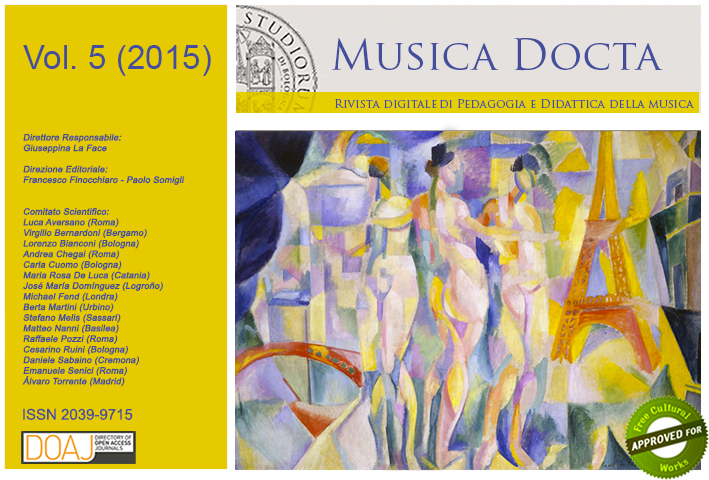Il “soggetto cavato” nella “Missa Hercules Dux Ferrariae” di Josquin des Prez
DOI:
https://doi.org/10.6092/issn.2039-9715/5879Abstract
The article describes a didactic approach to comprehension and production for junior secondary school, focusing on the Kyrie of the Missa Hercules dux Ferrariae by Josquin Des Prez. As is known, Josquin composed this work using the technique of “soggetto cavato” and ‘carved’ the tenor out of a text motto addressed to the dedicatee. The first step in the assignment is listening comprehension, which also includes a brain teasing and an ear training activity. Students are asked to codify the succession of pitches in the tenor in a way that allows to go back to the original motto used by Josquin. This experience puts students back to the center of the interpretive process, and at the same time helps introduce some important notions in Renaissance musical reception, such as that of musica reservata. In the ensuing step, that of production, the rules inferred from the analysis of the Kyrie are put into practice, for the purpose of creating a small two-part polyphonic composition. For students this involves composing a tenor with the “soggetto cavato” technique, converting a short verbal motto of their choice into a short sequence of pitches. Students are then asked to complement the tenor with a second, freer part, modeled after Josquin’s Kyrie. During the whole assignment, in particular during the production stage, students use a music notation software, which gives them greater control over the final result while writing the composition. The author personally supervised these activities in several classes as part of the Music curriculum program for junior secondary schools, collecting the results in the Aulodie blog.Downloads
Pubblicato
2015-12-28
Come citare
Izzo, L. (2015). Il “soggetto cavato” nella “Missa Hercules Dux Ferrariae” di Josquin des Prez. Musica Docta, 5(1), 139–150. https://doi.org/10.6092/issn.2039-9715/5879
Fascicolo
Sezione
Percorsi didattici
Licenza
Copyright (c) 2015 Leo Izzo
I diritti d'autore di tutti i testi nella rivista appartengono ai rispettivi autori senza restrizioni.
La rivista è rilasciata sotto una licenza Creative Commons Attribuzione Condividi allo stesso modo 4.0 Internazionale (codice legale completo).
Vedere inoltre la nostra Open Access Policy.
Metadati
Tutti i metadati dei materiali pubblicati sono rilasciati in pubblico dominio e possono essere utilizzati da ognuno per qualsiasi scopo. Questi includono i riferimenti bibliografici.
I metadati – riferimenti bibliografici inclusi – possono essere riutilizzati in qualsiasi formato senza ulteriori autorizzazioni, incluso per scopo di lucro. Chiediamo cortesemente agli utenti di includere un collegamento ai metadati originali.






